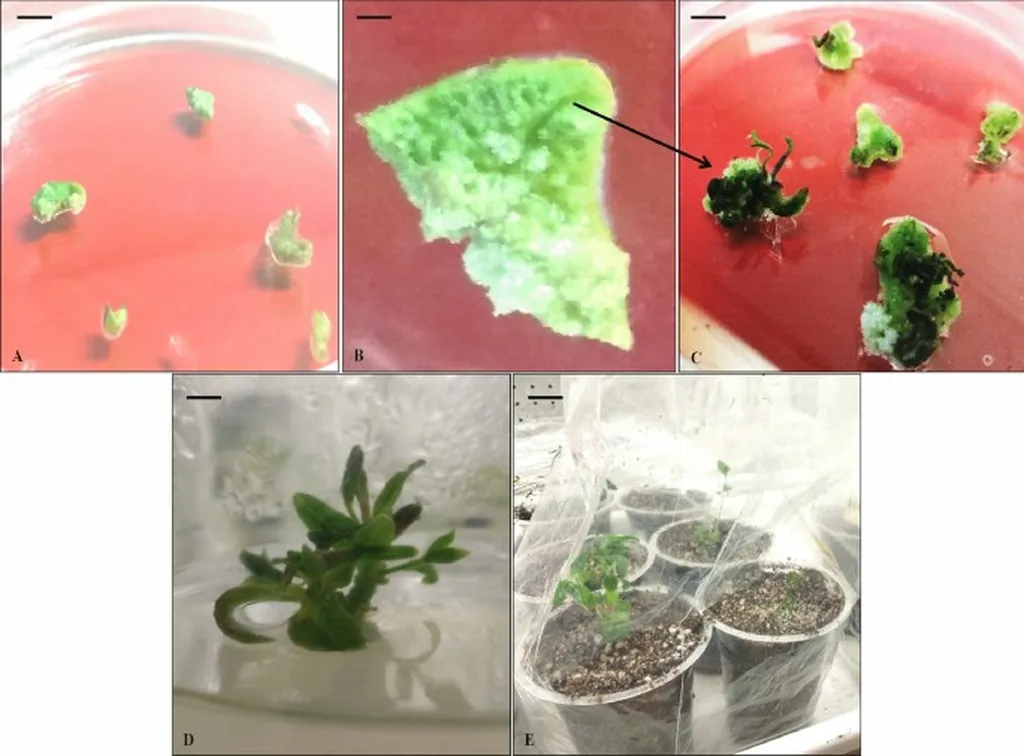In the quest for sustainable and natural alternatives to sugar, Stevia rebaudiana has emerged as a promising candidate. A recent study published in the journal *Frontiers in Plant Science* (translated from English as “Frontiers in Plant Science”) explores the potential of callus culture-derived regeneration of Stevia rebaudiana, with significant implications for the production of steviol glycosides (SGs) and genetic stability. The research, led by Pritom Biswas from the Department of Biotechnology at the Central University of South Bihar in India, offers insights that could revolutionize the commercial production of this zero-calorie sweetener.
The study focuses on optimizing the regeneration process of Stevia rebaudiana from callus, a mass of undifferentiated plant cells. By using Murashige and Skoog (MS) medium supplemented with specific plant growth regulators, the researchers achieved an impressive 89.20% callus induction rate from leaf explants. “The key was finding the right combination of Naphthalene acetic acid (NAA) and 2,4-Dichlorophenoxyacetic acid (2,4-D) to stimulate callus growth,” explains Biswas. This optimized medium not only induced callus formation but also resulted in maximum biomass, setting the stage for successful shoot regeneration.
For shoot regeneration, the researchers found that MS medium containing NAA and 6-Benzylaminopurine (BAP) was most effective, yielding a remarkable 87.77% shoot induction rate. The regenerated shoots were then transferred to a quarter-strength MS medium with Indole-3-acetic acid (IAA) for rooting. This approach significantly enhanced rooting efficiency, with the highest rooting percentage (88.40%) and longest roots (3.41 cm) observed. The acclimatized plantlets demonstrated a survival rate of 77-78% and closely resembled the parent plants in morphology.
One of the most compelling findings of the study is the higher concentration of steviol glycosides in the leaves of in vitro regenerated plants compared to callus. High-performance liquid chromatography (HPLC) analysis revealed that ex vitro leaves, in particular, showed the highest content of both stevioside and rebaudioside A, the primary compounds responsible for Stevia’s sweetness. “This suggests that the regeneration process not only maintains but potentially enhances the production of these valuable compounds,” notes Biswas.
Genetic stability is another critical aspect of the study. Using Random Amplified Polymorphic DNA (RAPD) and Inter Simple Sequence Repeats (ISSR) markers, the researchers conducted a genetic analysis of the regenerated plants. The consistent amplification profiles observed revealed no polymorphic bands, indicating minimal somaclonal variation. This finding is crucial for ensuring the genetic integrity of Stevia rebaudiana during the regeneration process.
The implications of this research are far-reaching, particularly for the commercial production of Stevia rebaudiana. The ability to regenerate plants with enhanced steviol glycoside production and genetic stability opens up new avenues for large-scale cultivation and processing. This could lead to a more sustainable and cost-effective supply of natural sweeteners, addressing the growing demand for healthier alternatives to sugar.
Moreover, the study highlights the potential of callus culture as a powerful tool for plant biotechnology. By optimizing the regeneration process, researchers can not only improve the production of valuable compounds but also ensure the genetic stability of the regenerated plants. This approach could be applied to other plant species, paving the way for advancements in agriculture and biotechnology.
As the world continues to seek sustainable and natural solutions, the findings of this study offer a promising path forward. The work of Pritom Biswas and his team at the Central University of South Bihar underscores the importance of innovative research in addressing global challenges. With the publication of this study in *Frontiers in Plant Science*, the scientific community is one step closer to unlocking the full potential of Stevia rebaudiana and other valuable plant species.

